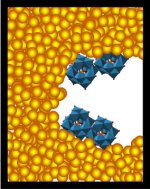The Secret Lives of Catalysts
Scientists use innovative tools to look deeper into chemical reactions than ever before
(July 2009)

Researchers at Pacific Northwest National Laboratory used innovative techniques to study, at the molecular level, the behavior of the heteropoly acid catalyst (blue clusters) on zeolite (yellow). Enlarge Image.
Results: With energy demands increasing around the globe, engineers continually look for ways to squeeze more fuel out of crude oil faster and with less waste. But optimizing energy production depends on understanding and perfecting the use of catalysts, which cause chemical reactions that break down the molecules of raw materials like oil to create fuel such as gasoline. Traditional techniques to measure a catalyst's performance can define structure, particle size, and chemical composition, but they can't tell engineers what is working and what isn't.
Now scientists at Pacific Northwest National Laboratory's Institute for Integrated Catalysis may have found a better approach. By using an innovative modification of a technique widely used for chemistry studies, they were able to determine the effectiveness of a catalyst, down to the molecular level.
Why it matters: Recent research has suggested that even the most important catalysts used in industry aren't working as effectively as they could. As much as 90% of the catalyst may do nothing more than sit on the surface of the structure that supports them, completely uninvolved in the important process of changing raw material into fuel. Being able to determine exactly what percentage of the catalyst is performing correctly is key to learning how to improve performance and could dramatically improve energy production processes.
Methods: Limited by the traditional techniques to peer into the inner workings of catalysts, PNNL's materials scientists turned to their colleagues in chemistry to help them solve the complicated problem of determining catalytic performance. Nuclear magnetic resonance (NMR) spectrometry uses radio waves and a powerful magnet linked to a computer to create detailed analysis of a material such as a catalyst. The researchers used NMR and other resources in the Department of Energy's EMSL, a national scientific user facility at PNNL.
To apply NMR to understanding catalysts, Dr. Kake Zhu, Dr. Jian Zhi Hu, Dr. Xiaoyan She, Dr. Jun Liu, Zimin Nie, Dr. Yong Wang, Dr. Charles Peden, and Dr. Ja Hun Kwak started with a common catalyst called heteropoly acid, which has been widely studied. They chose an equally common support called zeolite, which contains pores uniquely suited for many catalytic reactions. Even the smallest molecule of heteropoly acid, however, is too large to fit into the pores of most zeolites. To widen the pores, the researchers used a template of spherical carbon particles, like marbles at one-billionth the usual size. Once embedded in the zeolite, the carbon marbles can be burned out, leaving holes behind for the catalyst to fill.
The PNNL scientists then studied the catalytic performance of the zeolite-supported heteropoly acid catalyst using a special technique in NMR spectrometry that allowed them to probe how much of the catalyst is dispersed and then compare that to measurements of the catalyst's performance. Using the state-of-the-art NMR technique, they found that the catalyst dispersed inside pore channels was active (working), but the catalyst deposited on the outer surface was not active. Even with the catalyst and support material specially designed to work at peak performance, only 40% of the catalyst was working.
What's next: Now that Institute for Interfacial Catalysis researchers have been able to determine how much of a catalyst is working, they want to understand the reasons why. "We need to systematically change the parameters of the support and the catalyst itself, such as particle size, surface area, and amount of heteropoly acid catalyst," said Dr. Jun Liu, who is leading PNNL's Transformational Materials Science Initiative. "We plan to determine what factors prevent a catalyst from working and how to eliminate them."
Acknowledgments: This work was supported by the DOE Office of Basic Energy Sciences and Laboratory-Directed Research and Development funding. The NMR along with the transmission electron microscope used in the experiments is located in DOE's EMSL, a national scientific user facility at PNNL.
Reference: Zhu K, J Hu, X She, J Liu, Z Nie, Y Wang, CHF Peden, and JH Kwak. 2009. "Characterization of Dispersed Heteropoly Acid on Mesoporous Zeolite Using Solid-State 31P NMR Spin-Lattice Relaxation." Journal of the American Chemical Society 131(28):9715-9721.
